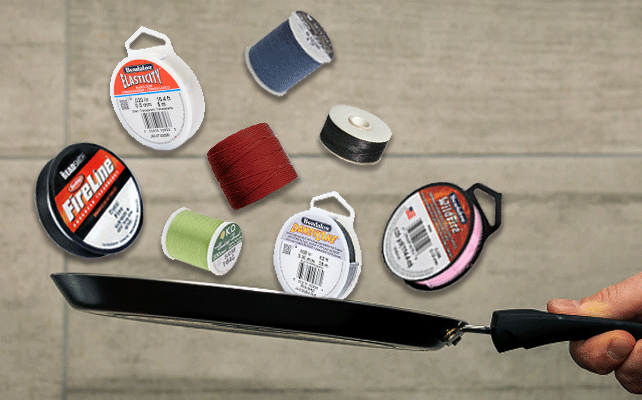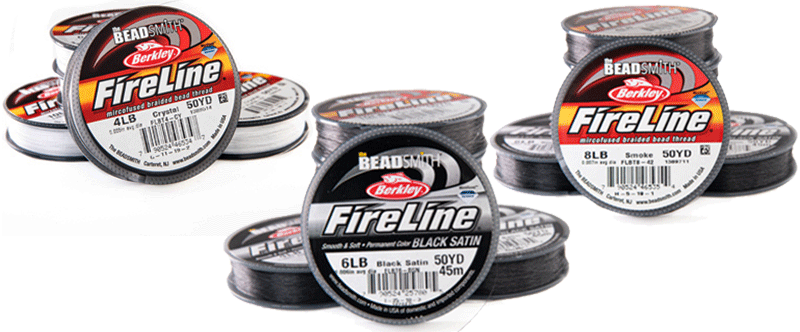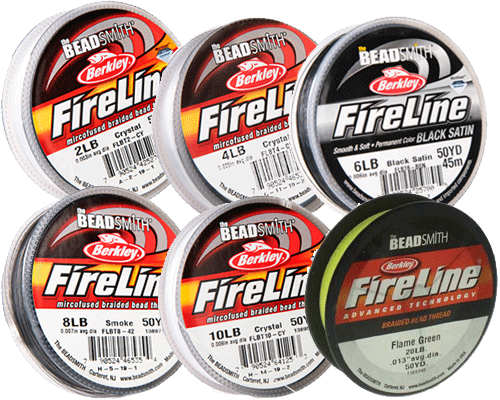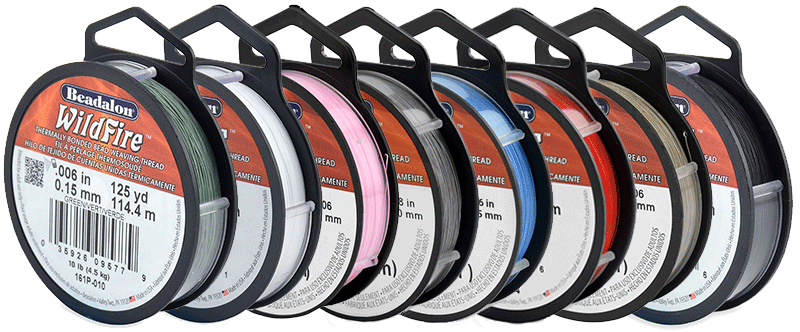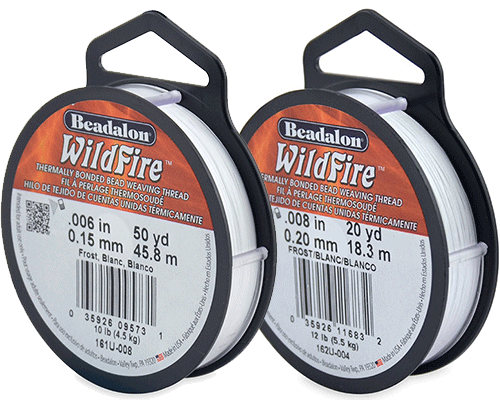Choosing The Right Beading Thread And Cord FireLine and WildFire by Damaris Ramenaden |
It's a question we are regularly asked - which is the best beading thread to buy? And our answer is... uuummm, aaahhhh, well... it depends on what you want to do with it.
Like most things in the beading and crafting world, there are usually a few options that will do mostly the same sort of thing; it's knowing the little details about each product that helps you to make a final decision.
In this series of short blogs we'll be exploring and comparing the different types of beading threads we offer and maybe you'll be tempted to flip your usual beading thread to try something new.
We'll kick off with FireLine first, as it's one of our most popular beading threads.
FireLine was originally manufactured by Berkley as a fishing line (have you noticed the fish logo on the spools before now?) and beaders being beaders saw how the properties of the line lent themselves perfectly to bead stitching.
Although there are multiple varieties of FireLine sold in the fishing industry, BeadSmith manufacture and distribute the original FireLine for the beading market (hence the BeadSmith logo on the spools too), with no change to the their formula and manufacturing process.
FireLine has always been made with Dyneema® which is considered to be the world’s strongest fibre. Dyneema® is a primary component in items such as personal armour (vests, shields, and helmets), cut-resistant gloves and sails & riggings. This also means that it is not biodegradable - great for ensuring your beadwork stands the test of time, however this can also be a slight cause for concern for eco-minded beaders too.
It is braided and then fused to make it thin and strong, with a smooth finish. It holds a knot really well and has an incredibly high tensile strength, with a choice of breaking strains to choose from, which in turn affects the diameter of the thread:
2lb =.07mm/.003in. diameter 4lb = .12mm/.005 in. diameter 6lb = .15mm/.006 in. diameter 8lb = .17mm/.007 in. diameter 10lb = .20mm/.008 in. diameter 14lb = .22mm/.009 in. diameter 20lb = .30mm/.012 in. diameter 30lb = .38mm/.015 in. diameter |
A variety of diameters means you can tailor the FireLine to your project - most projects call for a 4lb or 6lb thread, but if you're using crystals and beads with a sharp edge then go for a thicker thread if possible; if there are more thread passes and paths then aim for a thinner thread and build up the strength with multiple thread layers. As FireLine is microfused, you won't pierce it with a needle, or create snags and thread fluff with continuous passes.
It's worth noting here that FireLine has pretty much zero stretch, which is great for holding beading structures such as bezels, Right Angle Weave stitch, Peyote or any cubic or 3D stitch etc. However, it also means that your beadwork may be inflexible and prone to snapping if placed under too much stress, such as for Cellini Spiral stitch or Peyote wrapping. Of course, your tension can also play a part in this too; we'd always recommend making sure your beadwork isn't too tight and has the ability to move slightly if possible.
As it is a pre-waxed thread of gel-spun polyethylene, there is no need to wax your thread before you use it - however there is no harm if you do this as a matter of course, it will just make your thread thicker and stiffer still. It also means that it can be stiff enough not to need a needle for basic stringing, nor will it fray at the ends, though once you start using more advanced off-loom stitched and multiple thread passes, a needle is indispensable!
Some people find threading a needle with FireLine tricky (even though the 4lb and 6lb threads will fit a size 12 English beading needle). To overcome needle threading problems you can squash the end of the thread with pliers to make it 'flatter' for passing through the eye. We'd also suggest using specialist scissors for cutting FireLine; due to the strength and thread make up normal beading scissors will quickly become blunt or even damaged.
Our FireLine is available in three colours - Crystal (white), Smoke (grey) and Black Satin (a rich black). In the past, the Smoke FireLine has been found to rub off or transfer its colour to hands and working spaces, however the newer Black Satin overcomes this problem.
Fireline's high quality and durability is reflected in the price, however it can be financially more sound to buy a longer length reel than several smaller length reels. We sell Fireline in small 15yd reels (perfect if you're new to FireLine and want to try it out before investing heavily in it), 50yd reels and 125yd reels. We can also order in 300yd and 1500yd reels (POA). If you wish to do this please contact us to discuss your needs.
Let's take a look at WildFire now, and make some comparisons!
WildFire is manufactured and distributed by Beadalon. Similar to FireLine, WildFire is a thermally bonded beading thread; the synthetic fibres are fused together via heating process which creates a smooth and strong thread. Again, it knots really well when you want it to, and can be untangled when you need. It has a high breaking strain and is stretch resistant and waterproof.
Originally available in just white and black colours, Beadalon has since added further colourfast colours to the range, including red, blue and grey. Perhaps most notable is their green colour that magically works up neutrally and seems to work with just about any bead colour, their beige colour to work with all warm-toned neutrals and their pink colour to work with all pink or cool-toned neutrals.
WildFire does not fray and is also stiff enough to not need a needle for simple stringing, but for more intricate work, it works well with a needle - though again you might have to squash the ends with pliers to get it to pass through the needle eye. Likewise, you'd also need to use dedicated, sharp scissors to cut it, as it will damaged standard beading scissors. You can use a thread zapper on WildFire to great effect (as you can with FireLine too).
It is suitable for most beading projects, especially pieces that have intense or constant use. It is great for loom and off-loom bead stitching, but, like FireLine, you want to ensure you allow for a little movement and flexibility in your tension, otherwise you may find your beads all over the floor!
WildFire differs from Fireline when it comes to diameter availability. There are only two diameters available:
10lb = .15mm/.006 in. diameter 12lb = .20mm/.008 in. diameter Again, the price of WildFire reflects its quality and durability. We sell WildFire in three reel lengths - 20yd, 50yd and 125yd. We can also order in 300yd reels for better value (POA). If you wish to do this please contact us to discuss your needs. |
So which thread is best?
Actually, there's not really much in it - both threads are thermally bonded so won't fray, stretch or get pierced by a needle. They are both super strong, can hold a knot and are waterproof. We'd always recommend having a dedicated pair of sharp scissors just for these threads, and a thread zapper can go a long way to helping finish your work neatly.
Essentially, they are both heavy weights in the beading world with the same pros and cons. The biggest differences are more due to the colour and diameter choice - FireLine has more width and length options, however WildFire has more colour choices, including that green that magically melts into most colour palettes.
We think that if you tend to work with just one of these threads, you could easily incorporate the other into your work with minimal disruption - great to know if there are any world wide shortages going on!

